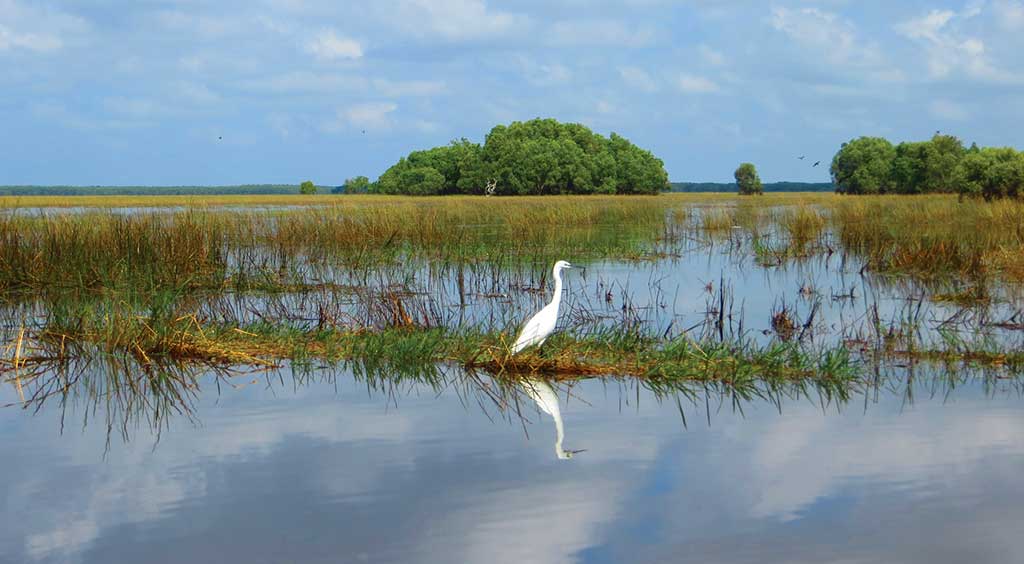Stretching over 2,000 miles along the East Sea, Vietnam is home to countless varieties of flora and fauna. From the peaks of Sapa all the way down to the watery Mekong Delta, the country’s range of climates and habitats lends itself to an equally diverse array of plant and wildlife. However, with an ever-growing population and a rapid pace of development, many of Vietnam’s plant and animal species are in danger. Deforestation and the overuse of natural resources threaten to erase natural habitats, while several species, some of which are unique to Vietnam, have become critically endangered in recent years due to the illegal wildlife trade. High demand for animal parts, such as rhino horn, has forced a handful of primates, turtles, and other creatures onto the IUCN Red List, which documents the world’s most endangered flora and fauna.

A stork in Tram Chim National Park. Photo © Dana Filek-Gibson.
Authorities have stepped up their punishment of poachers in recent years, but the wildlife trade continues to be a problem in Vietnam.While Vietnam boasts 30 protected national parks and nature reserves across the country, not all are strictly supervised. Authorities have stepped up their punishment of poachers in recent years, but the wildlife trade continues to be a problem in Vietnam. In 2011, WWF confirmed that the country’s small population of Javan rhino, an extremely rare animal, was officially extinct after the last of its kind was likely killed by poachers. Additionally, nearly one-third of the country’s protected lands occur in and around the Mekong Delta, a region already straining under high population density. While the forests and jungles of Vietnam contain countless fascinating creatures, the country still has a ways to go in protecting its natural resources and bringing the 77 species of flora and fauna currently listed as critically endangered on IUCN’s Red List back to a healthy number.According to the World Bank’s World Development Indicators, a staggering 45 percent of Vietnam’s land area is covered by forest. These woodlands can be broken down into several categories, from the dry lowland forests of southern Vietnam, largely made up of tropical hardwood, to the flooded forests of mangroves and cajuput trees in that same region. Highland forests cover the northern region under a dense canopy of broad-leaved trees and moss. Inland, cooler climates like that of Lang Biang Plateau, are home to pine forests, which coexist alongside groves of bamboo. Fruit trees are common in the Mekong Delta, with jackfruit, durian, longans, rambutans, and papayas aplenty. Commercially prized woods like teak, rosewood, and ebony are raised here, as is bamboo. Rattan, an extremely durable wood used in basket-weaving, particularly by the minority communities of the north, is also prevalent.
A growing number of people flock to the country’s seaside areas, pushing many animals out of their natural habitats. In a region with many endemic species, Vietnam’s fauna holds its own array of endangered creatures. Larger species like the Indochinese tiger, moon bear, and Asian elephant often take center stage thanks to their size and prominence around the world, but Vietnam is also home to a host of native species that are found only within its borders. Even today, scientists continue to discover rare creatures, like the thorny tree frog, an amphibian that lives only among the highest peaks of Vietnam in its remote northern region, and as late as the 1990s, large mammals were still being found in the dense forests of central and northern Vietnam. The most elusive of these is the saola, an ox-like creature with long horns that is sometimes called the Asian unicorn due to its rarity.
Chances are you won’t get a glimpse of Vietnam’s more exotic animals during your visit. Travelers are more likely to encounter domestic creatures during their trip: chickens are common even in urban centers like Ho Chi Minh City, where they are sometimes kept as pets; pigs and water buffalo are abundant in the countryside.
Those eager to see Vietnam’s more exotic creatures, particularly its many varieties of primates, are encouraged to view these animals in the wild rather than at a zoo or tourist attraction, as the creatures in these centers tend to be mistreated and sometimes aggressive. The majority of Vietnam’s wildlife lives in national parks and nature reserves. National parks in Con Dao and Cat Ba have wild populations of different primates, including macaques, langurs, and gibbons, while both Cuc Phuong National Park and the Cu Chi Wildlife Rescue Center rehabilitate endangered primates, turtles, and other animals captured in the wildlife trade, providing a closer look at these creatures in an environment where they are safe and well looked after.
Excerpted from the First Edition of Moon Vietnam.